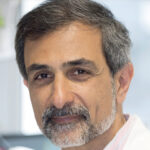Link to Pubmed [PMID] – 19089364
Methods Mol. Biol. 2009;482:295-317
Stem cells are present in all tissues and organs, and are crucial for normal regulated growth. How the pool size of stem cells and their progeny is regulated to establish the tissue prenatally, then maintain it throughout life, is a key question in biology and medicine. The ability to precisely locate stem and progenitors requires defining lineage progression from stem to differentiated cells, assessing the mode of cell expansion and self-renewal and identifying markers to assess the different cell states within the lineage. We have shown that during lineage progression from a quiescent adult muscle satellite cell to a differentiated myofibre, both symmetric and asymmetric divisions take place. Furthermore, we provide evidence that a sub-population of label retaining satellite cells co-segregate template DNA strands to one daughter cell. These findings provide a means of identifying presumed stem and progenitor cells within the lineage. In addition, asymmetric segregation of template DNA and the cytoplasmic protein Numb provides a landmark to define cell behaviour as self-renewal and differentiation decisions are being executed.

